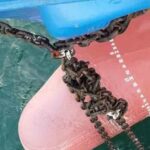Real Life Incident: Collision Claims Lives Of 18 Crew Members
A loaded bulk carrier was inbound to its destination port with a bridge team consisting of the Master, an OOW, a helmsman and two pilots. There were a light westerly breeze and a smooth sea with visibility at about 2nm and a light drizzle. Pilot A had the con. Pilot B reported to Pilot A that he had observed a radar target fine on the starboard bow at a range of about 2.5nm. The target was a seagoing tug on a course of about 090° and was making near 10kt. The bulk carrier was heading 260° at about 13.5kt.
A few minutes later, pilot B tried to attract the attention of the tug by flashing the Aldis lamp in its direction. The tug was still very fine on the starboard bow and now at a range of about 1.6nm, showing a red sidelight. The pilots expected the tug to alter course to starboard, but instead, it maintained course and speed.
Shortly after this, pilot A asked pilot B to contact the vessel traffic centre (VTC) to provide information on the target and to advise the tug that the two vessels should pass port to port to avoid a collision. VTC called the tug and instructed them to take action to avoid collision. Although the tug responded, it was impossible to understand the response. A few minutes later pilot A instructed the helmsman to alter course slowly to starboard to 265° in order to enter the deep water channel with the CP1 buoy close on the starboard side.

A few minutes later, the tug was very fine on the port bow of the bulk carrier and at a range of about 0.5nm. Pilot A gave a helm order of starboard 10 with a view to keeping the tug on the port bow and giving it as much room as possible to pass on the port side. Pilot B gave one short blast on the whistle. Within seconds, the tug was observed to alter course rapidly to port. Pilot A ordered the helmsman to put the wheel to starboard 20, and followed by hard to starboard. Pilot B sounded five short and rapid blasts on the whistle.
As the tug continued to alter her course to port and her masthead lights opened more widely. Pilot B again sounded five short and rapid blasts on the whistle. Pilot A then gave a port 10 helm order in order to the reduce rate of turn of the bulk carrier to starboard and to allow the tug to pass clear ahead.
Pilot A then gave a helm order of starboard 10, but the bow of the bulk carrier struck the starboard quarter of the tug. The collision impact was heavy and the bulk carrier was brought to a stop. Shortly after the collision the tug listed to starboard and sank. Seven persons were rescued from the tug, but 18 crew were trapped and drowned inside the vessel.
Lessons learned
- Never make small course alterations when faced with an ambiguous meeting or crossing situation.
- Make your intentions known by using a large course alteration, preferably to starboard as per the collision regulations.
- When in doubt, slow down.
Reference: nautinst.org
Do you have info to share with us ? Suggest a correction
About Author
Marine Insight News Network is a premier source for up-to-date, comprehensive, and insightful coverage of the maritime industry. Dedicated to offering the latest news, trends, and analyses in shipping, marine technology, regulations, and global maritime affairs, Marine Insight News Network prides itself on delivering accurate, engaging, and relevant information.

About Author
Marine Insight News Network is a premier source for up-to-date, comprehensive, and insightful coverage of the maritime industry. Dedicated to offering the latest news, trends, and analyses in shipping, marine technology, regulations, and global maritime affairs, Marine Insight News Network prides itself on delivering accurate, engaging, and relevant information.
- Real Life Incident: Vessel Collision in Good Visibility
- Real Life Incident: Severe Injury To Deck Crew While Leaving Berth
- Real Life Incident: Departure Damage in Very Restricted Waterway
- Real Life Incident: Low Situational Awareness Has High Impact Consequence
- Real Life Incident: Fouled Anchor in a Designated Anchorage
- Real Life Incident: Fire On Barge Carrying Scrap Metal Causes $7 Million Worth Of Damage
Latest Case studies Articles You Would Like:
Subscribe To Our Newsletters
By subscribing, you agree to our Privacy Policy and may receive occasional deal communications; you can unsubscribe anytime.
















Please Explained All About This Accident in Detailed. Along with the Correspondent To The Competens Authority. Final Inquiry Report by the Port State Contoral. Seaworthyness Certificates Of This Tug.Join As Seagoing vessels Position From Government Shipping Office. Or join Through Offshore Marine H.R. Contractor. The Victims Must be Eligible & Allowed Compensation. As Per ITF & ILO Convention